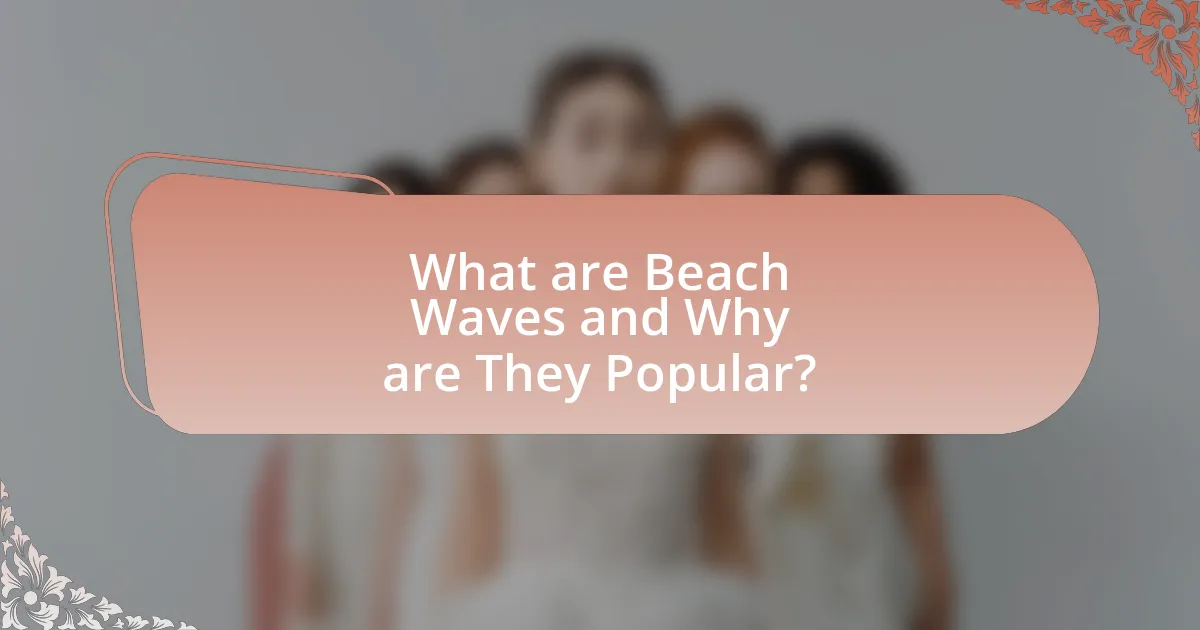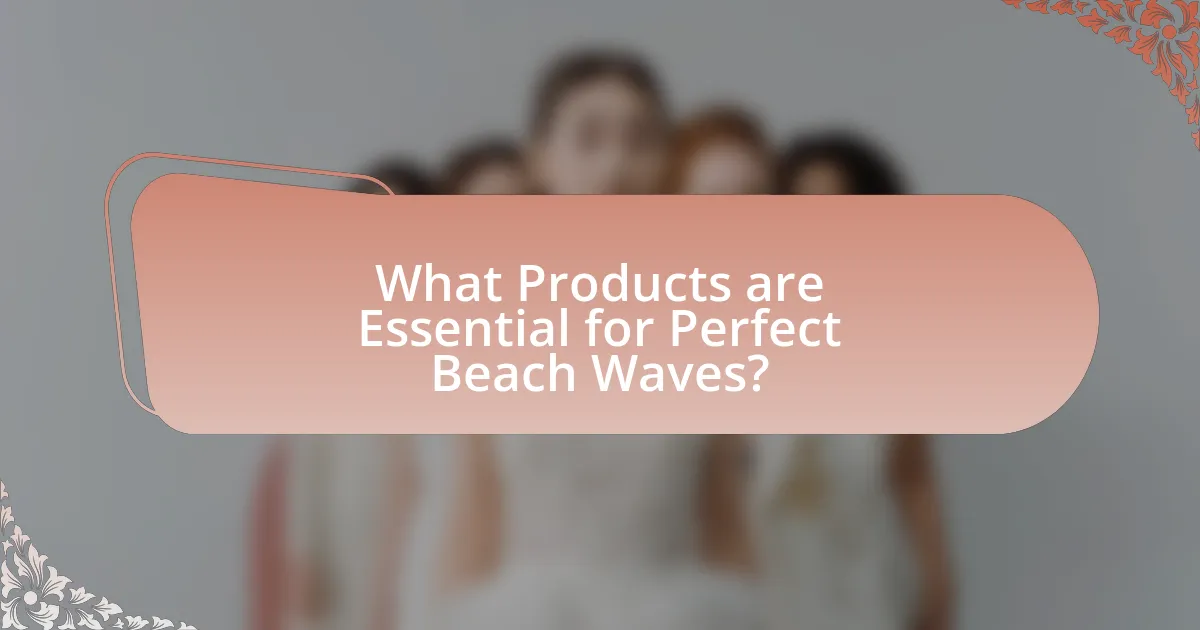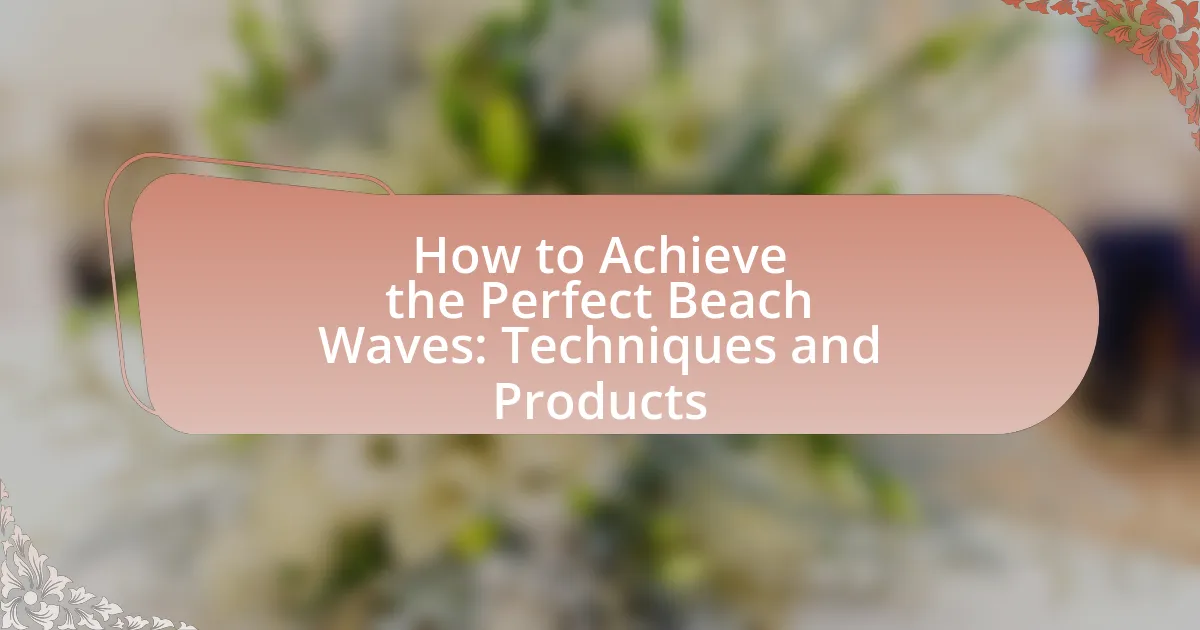The article focuses on achieving the perfect beach waves, a popular hairstyle characterized by loose, tousled curls that emulate the natural texture of hair after a day at the beach. It outlines the defining characteristics of beach waves, differentiating them from other hairstyles, and discusses various techniques for creating them, including heat styling and no-heat methods. Additionally, the article highlights essential products such as sea salt sprays and texturizing mousse that enhance the texture and longevity of beach waves. It also addresses factors like hair type and length that influence the outcome, along with common mistakes to avoid for optimal results.

What are Beach Waves and Why are They Popular?
Beach waves are loose, tousled curls that mimic the natural texture of hair after a day at the beach, characterized by a relaxed and effortless appearance. They are popular because they provide a casual yet stylish look that suits various occasions, appealing to individuals seeking a low-maintenance hairstyle. The trend gained momentum due to social media influencers and celebrities showcasing beach waves as a go-to summer hairstyle, reinforcing their desirability. Additionally, the versatility of beach waves allows them to complement different hair types and lengths, making them accessible to a wide audience.
How do Beach Waves differ from other hairstyles?
Beach waves differ from other hairstyles primarily in their relaxed, tousled texture that mimics the natural waves created by ocean water. Unlike structured hairstyles such as straight hair or tight curls, beach waves are characterized by a more effortless, undone look, often achieved through techniques like braiding damp hair or using a curling wand with a larger barrel. This style typically emphasizes volume and movement, contrasting with sleek or polished hairstyles that prioritize uniformity and smoothness. The casual aesthetic of beach waves is often associated with a carefree, summery vibe, making it distinct from more formal or intricate hairstyles.
What are the defining characteristics of Beach Waves?
Beach waves are characterized by their loose, tousled texture and natural appearance, resembling the effortless waves created by ocean currents. These waves typically feature a soft, relaxed curl that adds volume and movement to the hair, often with a slightly messy finish. The defining traits include a blend of straight and curled sections, creating an organic look that mimics the effect of saltwater and sun exposure. This style is often achieved using specific techniques such as braiding damp hair or utilizing curling wands, along with products like sea salt sprays that enhance texture and hold.
Why do people prefer Beach Waves for casual and formal occasions?
People prefer beach waves for casual and formal occasions because they offer a versatile, effortless look that complements various styles. Beach waves create a relaxed yet polished appearance, making them suitable for both laid-back settings and more sophisticated events. The texture and movement of beach waves enhance natural beauty, allowing individuals to express their personal style while maintaining an elegant aesthetic. This adaptability is supported by the fact that many celebrities and influencers frequently showcase beach waves at red carpet events and casual outings alike, reinforcing their popularity across different contexts.
What factors contribute to achieving the perfect Beach Waves?
Achieving the perfect beach waves primarily depends on hair texture, product choice, and styling technique. Hair texture influences how waves form; for instance, naturally wavy or curly hair tends to hold waves better than straight hair. The choice of products, such as sea salt sprays or texturizing creams, enhances the wave formation by adding grip and volume. Additionally, the styling technique, including methods like braiding damp hair or using a curling wand, significantly impacts the final look. Research indicates that using a combination of these factors can lead to optimal results, as demonstrated in studies on hair styling efficacy.
How does hair type affect the outcome of Beach Waves?
Hair type significantly influences the outcome of beach waves, as different textures and densities respond uniquely to styling techniques. For instance, straight hair often requires more effort to achieve defined waves, typically needing heat styling tools or products that enhance texture. In contrast, wavy hair naturally holds beach waves more easily, often requiring minimal styling. Curly hair may need specific techniques, such as twisting or braiding, to create waves without losing its natural curl pattern. Research indicates that hair’s porosity also plays a role; higher porosity hair absorbs products better, which can enhance wave definition and longevity. Thus, understanding one’s hair type is crucial for effectively achieving the desired beach wave look.
What role does hair length play in creating Beach Waves?
Hair length significantly influences the creation of beach waves, as longer hair typically allows for more pronounced and defined waves. Longer strands provide greater surface area for styling techniques, such as curling or waving, which can enhance the texture and volume associated with beach waves. Additionally, longer hair can hold waves better due to its weight, allowing for a more natural fall and movement. Studies in hair styling indicate that hair length directly correlates with the ability to achieve various wave patterns, with longer hair often yielding more versatile styling options.

What Techniques Can Be Used to Create Beach Waves?
Techniques to create beach waves include using a curling wand, braiding damp hair, and applying sea salt spray. A curling wand allows for defined waves by wrapping sections of hair around the barrel, while braiding damp hair overnight creates natural waves as it dries. Sea salt spray enhances texture and provides a tousled look, mimicking the effect of ocean water on hair. These methods are widely used in hairstyling, with many professionals recommending them for achieving effortless beach waves.
How can you achieve Beach Waves using heat styling tools?
To achieve beach waves using heat styling tools, utilize a curling wand or flat iron to create loose, tousled curls. Start by sectioning the hair into manageable parts, then wrap each section around the barrel of the curling wand or clamp it with the flat iron, holding for a few seconds before releasing. This technique mimics the natural waves formed by ocean water. For optimal results, apply a heat protectant spray beforehand to prevent damage, and finish with a texturizing spray to enhance the wave’s definition and hold.
What are the best practices for using a curling iron to create Beach Waves?
To create beach waves using a curling iron, section the hair into manageable parts, use a curling iron with a barrel size of 1 to 1.5 inches, and wrap the hair around the barrel in alternating directions. This technique mimics the natural wave pattern found in beach waves. Additionally, applying a heat protectant before styling helps prevent damage, while using a texturizing spray afterward enhances the wave’s hold and appearance. Studies show that using the right tools and products significantly improves the longevity and quality of the waves, making these practices effective for achieving the desired look.
How can a flat iron be used to achieve a wavy look?
A flat iron can be used to achieve a wavy look by employing a technique known as the “twist and glide” method. To execute this, take a section of hair, clamp the flat iron at the roots, and then twist the iron 180 degrees while pulling it down the length of the hair. This motion creates a wave pattern as the hair is heated and shaped. The effectiveness of this method is supported by the fact that flat irons can reach temperatures of up to 450°F, allowing for quick styling and long-lasting waves.
What are some no-heat methods for creating Beach Waves?
Some effective no-heat methods for creating beach waves include braiding damp hair, using twist buns, and employing the scrunching technique with sea salt spray. Braiding damp hair into multiple sections and allowing it to dry naturally creates soft waves; this method is widely recognized for its simplicity and effectiveness. Twist buns involve twisting sections of hair into small buns and securing them until dry, resulting in defined waves. Additionally, scrunching damp hair with sea salt spray enhances texture and volume, mimicking the natural wave pattern created by ocean water. These methods are popular among individuals seeking to achieve beach waves without the use of heat styling tools.
How can braiding your hair overnight create Beach Waves?
Braiding your hair overnight creates beach waves by allowing the hair to set in a twisted position, which enhances natural texture and curl formation. When hair is braided, the strands are compressed together, promoting wave patterns as they dry. This method utilizes the hair’s natural moisture and heat from the scalp to encourage the formation of soft, tousled waves without the need for heat styling tools. The result is a relaxed, beachy look that mimics the effect of saltwater and sun exposure, commonly associated with beach waves.
What is the technique for using sea salt spray for Beach Waves?
To achieve beach waves using sea salt spray, first, apply the spray to damp hair, ensuring even distribution from roots to ends. Next, scrunch the hair gently with your hands to encourage texture and wave formation. For enhanced results, you can twist sections of hair and allow them to air dry or use a diffuser on low heat. This technique works because sea salt spray mimics the natural texture created by ocean water, adding volume and definition to the hair.

What Products are Essential for Perfect Beach Waves?
To achieve perfect beach waves, essential products include sea salt spray, texturizing mousse, and lightweight hair oil. Sea salt spray mimics the texture and volume created by ocean water, providing a tousled look. Texturizing mousse adds body and hold, ensuring the waves last throughout the day. Lightweight hair oil helps to reduce frizz and adds shine, enhancing the overall appearance of the waves. These products work together to create the desired beachy texture while maintaining hair health.
What types of products should be used for styling Beach Waves?
To style beach waves, use sea salt spray, texturizing spray, and lightweight mousse. Sea salt spray mimics the texture of ocean water, providing grip and volume, while texturizing spray enhances definition and separation of waves. Lightweight mousse adds body without weighing hair down, ensuring a natural, effortless look. These products are commonly recommended by hairstylists for achieving the desired beachy texture.
How do texturizing sprays enhance the look of Beach Waves?
Texturizing sprays enhance the look of beach waves by adding volume, definition, and a tousled texture that mimics the natural waves created by ocean water. These sprays typically contain ingredients like sea salt or minerals that create a gritty texture, allowing hair to hold its shape and maintain a relaxed, effortless appearance. The application of texturizing spray can also provide a matte finish, which further contributes to the authentic, sun-kissed look associated with beach waves.
What are the benefits of using sea salt sprays for Beach Waves?
Sea salt sprays provide texture and volume, making them ideal for achieving beach waves. These sprays mimic the effects of ocean water, enhancing hair’s natural waves and curls while adding a matte finish. Additionally, sea salt sprays can help create a tousled, effortless look that is often associated with beachy hairstyles. The salt content can also absorb excess oil, giving hair a fresher appearance. Furthermore, many formulations include nourishing ingredients that can hydrate and protect hair, contributing to overall hair health while styling.
How can you maintain Beach Waves throughout the day?
To maintain beach waves throughout the day, use a combination of sea salt spray and a light-hold hairspray. Sea salt spray adds texture and enhances the natural wave pattern, while a light-hold hairspray provides necessary hold without making the hair stiff. Studies show that products containing sea salt can mimic the effects of ocean water, which is known to create and sustain beachy waves. Additionally, reapplying the sea salt spray and hairspray as needed throughout the day can help refresh and maintain the waves, ensuring they remain defined and voluminous.
What are the best products for holding Beach Waves in place?
The best products for holding beach waves in place include sea salt sprays, texturizing sprays, and lightweight mousses. Sea salt sprays, such as Bumble and Bumble Surf Spray, create texture and enhance waves while providing a light hold. Texturizing sprays like Oribe Dry Texturizing Spray add volume and grip, making waves last longer. Lightweight mousses, such as Moroccanoil Volumizing Mousse, offer hold without weighing hair down, ensuring that beach waves remain defined and bouncy throughout the day. These products are formulated to mimic the natural texture and hold that ocean water provides, making them effective for achieving and maintaining beach waves.
How can you refresh Beach Waves on the second day?
To refresh beach waves on the second day, lightly mist your hair with water or a sea salt spray to reactivate the texture. This method helps to redefine the waves without the need for washing. Additionally, scrunch your hair gently with your hands to enhance the wave pattern. Using a light styling cream or mousse can also provide extra hold and definition. These techniques are effective because they utilize moisture to revive the natural wave structure while minimizing damage from heat styling.
What are some common mistakes to avoid when creating Beach Waves?
Common mistakes to avoid when creating beach waves include using too much heat, which can damage hair and lead to frizz. Additionally, not using a heat protectant can exacerbate this damage. Another mistake is sectioning hair too thickly, resulting in uneven waves; smaller sections create more defined curls. Overloading hair with product can weigh it down, preventing the desired light, airy look. Lastly, neglecting to let waves cool before styling can cause them to fall flat quickly.
How can overusing products affect the quality of Beach Waves?
Overusing hair products can lead to a decline in the quality of beach waves by causing buildup, which weighs down the hair and reduces its natural texture. When products such as gels, sprays, or creams are applied excessively, they can create a residue that prevents the hair from achieving the desired light, airy look characteristic of beach waves. This buildup can also lead to dryness and damage, making the hair less responsive to styling techniques that create waves. Studies indicate that hair products containing silicones or heavy oils can exacerbate this issue, as they are difficult to wash out and can accumulate over time, further compromising the hair’s health and appearance.
What should you avoid when using heat styling tools for Beach Waves?
When using heat styling tools for beach waves, you should avoid excessive heat exposure. Excessive heat can damage hair, leading to dryness and breakage. Studies indicate that temperatures above 350°F can significantly weaken hair structure, making it more prone to damage. Additionally, avoid using heat styling tools on wet hair, as this can cause steam damage and further weaken the hair cuticle.
What are the best tips for achieving the perfect Beach Waves?
To achieve the perfect beach waves, use a sea salt spray or texturizing spray on damp hair, then scrunch and twist sections of hair while allowing it to air dry. This method mimics the natural texture created by ocean water. Additionally, using a curling wand on random sections can enhance the waves, but ensure to alternate the direction of the curls for a more natural look. Research indicates that sea salt sprays can add volume and texture, making them effective for creating beach waves.


